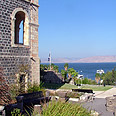
The Scottish Church
צילום: דוד הכהן
Waiting for Father Timothy
Prior to giving in to the temptations of the religious institutions in Jerusalem, Jesus, for ages the most famous Jew in the world, wandered around the Lower Galilee and the shores of the Sea of Galilee. Here's an organized tour of the small and hidden churches in the region that were inspired by his activities
Christmas, that recently united most of the Christian world, also filled churches throughout Israel. Israeli tourists in Europe never miss out the ancient cathedrals but rarely visit churches, in the land where the herald of Christianity was born. Those that do visit churches here usually do so as part of a private tour to well-known churches in and around Jerusalem, Nazareth, and north of the Sea of Galilee.
The Galilee Churches were established starting in the 16th century, when Muslim rulers, wanting to develop relations with European powers, permitted their representatives in the holy land to buy property and build places of worship.
Passing by one of these churches, one may only see high walls, a metal gate and a bell tower. But these walls, however often hide beautiful churches that call out for visitors.
The Scottish Church
Tiberias is mentioned only once in the New Testament. Here Jesus was able to operate away from the ruling government. He focused his activities in Kfar Nahum which was on the border of two Roman provinces. Many churches were established in Tiberius and its surroundings due to all of his activities on the shores of the Sea of Galilee.
The tour begins at the Scottish Church in Tiberias. Its origin is tied to the activities of a Scottish doctor name Dr. David Torrence, who in 1892 established the city's first hospital. The institution was open to everyone - Christians, Muslims and Jews. Over time, the hospital has served as a birthing center, and underwent a transformation two years ago and has been converted into “The Scots Hotel.”
The person responsible for overseeing the Church today is Ms Jane Zelinsky, a Scottish immigrant of Polish ancestry. In the Second World War, her father was forced to fight behind German lines, was captured by the British and then went to fight on the side of the Free Polish Forces.
His daughter spent a lot of time in the church in Tiberias and her activities here today focus on education and tourism. The church itself is modest: a nice basalt building, a garden with gravel and plants and a simple prayer hall, even spartan. There are occasional concerts held here.
It is necessary to call in advance in order to visit: Tel 04-6721165.
Casa Nova
Opposite the church is the impressive Casa Nova building, a hostel for Christian pilgrims who can pay according to their abilities. This is one of many similar guest houses for pilgrims (of the same name) that have been set up in Jerusalem, Bethlehem and other places.
Continuing along the trail you go down from the Scottish Church to the shore of the Sea of Galilee and turn to the Church of St. Peter. It is important to check the visiting hours. Churches in general are closed during most of the afternoon to allow for prayers and rest, so the best times to visit are in the morning or early afternoon.
The cupola (semi-circular alcove characteristic of church architecture) looks like to the bow of a ship from the outside since Peter was a fisherman, and also because an accepted image of the Christian church is the ship that leads believers forward.
Inside the prayer hall, on the right, one can see stained glass images of fish and other holy images. In the center of the cupola are the symbols of the Four Gospels and above them the image of Peter.
The fascinating part of this church is actually the back courtyard, where the statue of Peter, brought here in 1833, is an exact copy of the statue in the Church of St. Peter in Rome. There is also an interesting war memorial set up during World War II with images of mythological fighters and symbols of important cities in Poland.
Greek Orthodox Church
At the southern end of the Tiberias promenade is the Greek Orthodox Church. This complex includes a monastery and a church dedicated to Peter and Paul, and is situated on the ruins of a synagogue, (used by the 17th century Rabbi Yeshayahu Horowitz).
There are no visiting hours, you just knock on the door. Most of the time Father Timothy opens the door. He is an impressive figure and welcoming to guests.
The garden and building are impressive and well maintained, with an abundance of plants and even a parrot cage. First you go down towards the church which is basically made up of three houses of prayer.
An important feature common to all these churches is a wall of icons of holy images. Make sure to go up to the roof to see the view of the Sea of Galilee and the Golan Heights.










